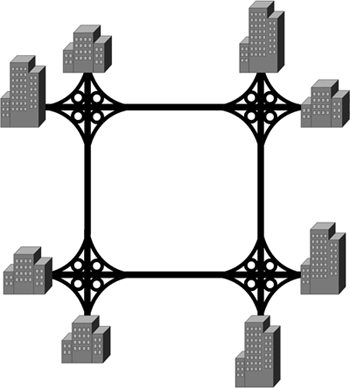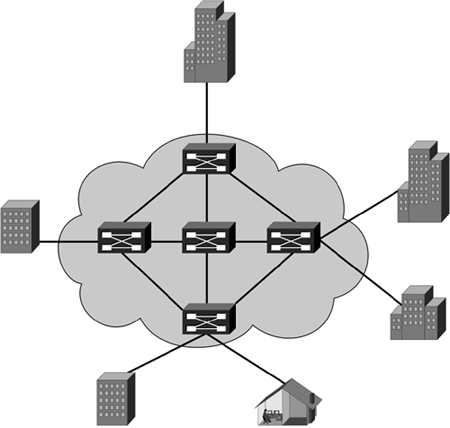WAN Architecture
The architecture of a WAN is much like the interstate highway system, with multiple sites interconnected by multiple paths and exchanges, as shown in Figure 8-10.
Figure 8-10. An Interstate Highway System That Looks Like a WAN

Highway on-ramps (local access loops) provide direct access from each city or town (in a WAN, the town would be the customer site) to the system, or network of interstate highways. The highway system works much the same way as a WAN, where WAN switches provide points where traffic "changes direction." Highway clover leafs enable the same operation to take place. The WAN, illustrated in Figure 8-11, enables communications transport between customer sites much like the highway enables vehicular transport between each city or town.
Figure 8-11. A WAN

WAN connectivity is enabled by the transport components within the network core. This network core is comprised of the following elements:
Multiplexers Merge several low-speed transmissions into one high-speed transmission (and vice versa). Multiplexers are found both at the network access and core, aggregating low-speed signals (for example, DS3) into a single high-speed signal (such as OC-12). The most prevalent multiplexer used in the NSP network is the M13 (Multiplexer DS1/DS3, pronounced "M-One-Three"). The M13 performs both multiplexing (combining) and demultiplexing (separating) functions. M13s multiplex 28 DS1 signals into a single DS3 signal for transmission, often terminating to the Fiber Optic Light Terminating Equipment (LTE), and demultiplex DS3 signals into 28 DS1 signals, often terminating into DACS (DXC) or voice/data switches.
NOTE
When we are discussing multiplexing, low-speed identifies the multiplexer input and high-speed identifies the multiplexer output, regardless of the actual bandwidth speeds in discussion.
WAN switches Connect network links in order to transport traffic throughout the WAN. WAN switches dictate the service provided by the WAN service provider, such as ATM, Frame Relay, and Internet (IP).
Repeaters Physical Layer devices that amplify or regenerate analog and digital signals across a physical link. Repeaters are used for long-distance transmission, such as a fiber optic cable across a large geographic area.
A Digital Access Cross-Connect Switch (DACS or DXC) Electronically switches the DS0s within each DS1. A DACS can provide network timing for dedicated T1 service, provided that the DACS (and customer's T1 CSU) are configured for such. In order for a DACS to provide network timing, the DACS port must be groomed as "T1 Intact."
ATM Data Exchange Interface (ATM DXI) Enables existing non-ATM routers to support ATM cells by providing a direct interface between a network service provider router and the customer CSU/DSU.
EAN: 2147483647
Pages: 269
- Chapter II Information Search on the Internet: A Causal Model
- Chapter III Two Models of Online Patronage: Why Do Consumers Shop on the Internet?
- Chapter VI Web Site Quality and Usability in E-Commerce
- Chapter X Converting Browsers to Buyers: Key Considerations in Designing Business-to-Consumer Web Sites
- Chapter XIV Product Catalog and Shopping Cart Effective Design